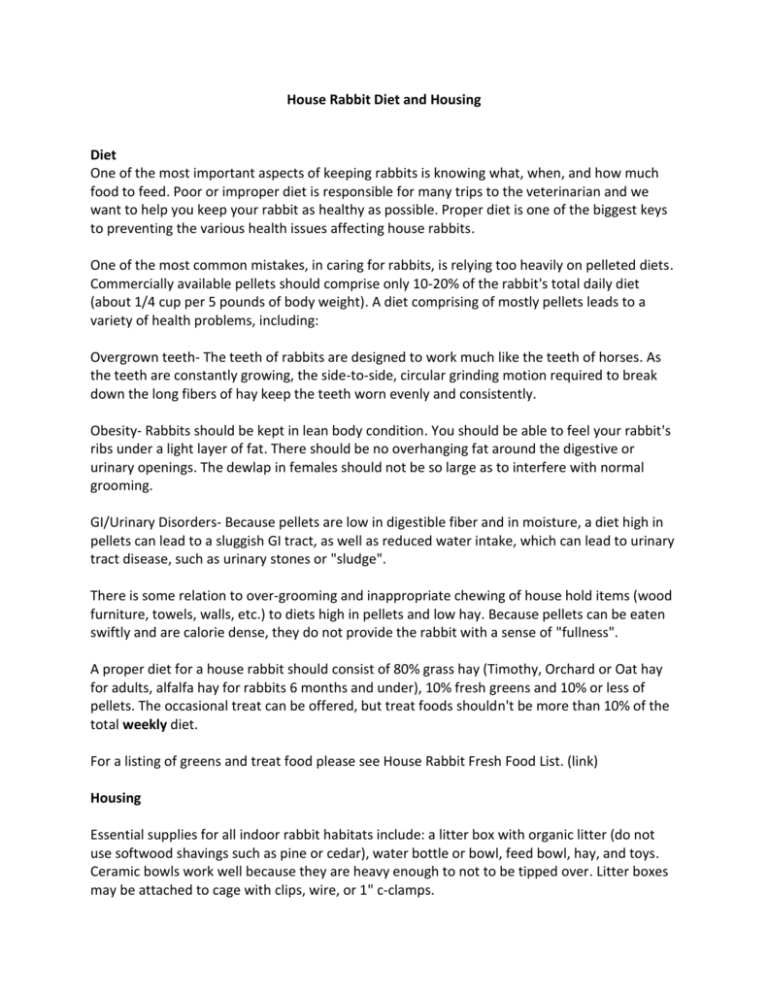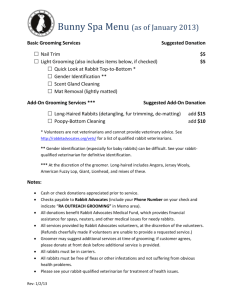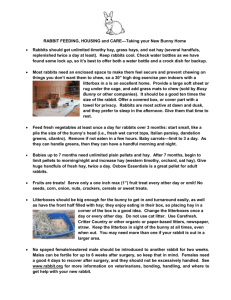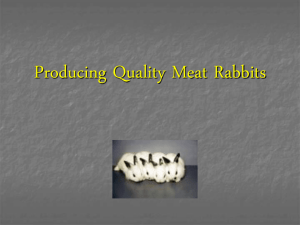Housing - Orange Grove Animal Hospital
advertisement

House Rabbit Diet and Housing Diet One of the most important aspects of keeping rabbits is knowing what, when, and how much food to feed. Poor or improper diet is responsible for many trips to the veterinarian and we want to help you keep your rabbit as healthy as possible. Proper diet is one of the biggest keys to preventing the various health issues affecting house rabbits. One of the most common mistakes, in caring for rabbits, is relying too heavily on pelleted diets. Commercially available pellets should comprise only 10-20% of the rabbit's total daily diet (about 1/4 cup per 5 pounds of body weight). A diet comprising of mostly pellets leads to a variety of health problems, including: Overgrown teeth- The teeth of rabbits are designed to work much like the teeth of horses. As the teeth are constantly growing, the side-to-side, circular grinding motion required to break down the long fibers of hay keep the teeth worn evenly and consistently. Obesity- Rabbits should be kept in lean body condition. You should be able to feel your rabbit's ribs under a light layer of fat. There should be no overhanging fat around the digestive or urinary openings. The dewlap in females should not be so large as to interfere with normal grooming. GI/Urinary Disorders- Because pellets are low in digestible fiber and in moisture, a diet high in pellets can lead to a sluggish GI tract, as well as reduced water intake, which can lead to urinary tract disease, such as urinary stones or "sludge". There is some relation to over-grooming and inappropriate chewing of house hold items (wood furniture, towels, walls, etc.) to diets high in pellets and low hay. Because pellets can be eaten swiftly and are calorie dense, they do not provide the rabbit with a sense of "fullness". A proper diet for a house rabbit should consist of 80% grass hay (Timothy, Orchard or Oat hay for adults, alfalfa hay for rabbits 6 months and under), 10% fresh greens and 10% or less of pellets. The occasional treat can be offered, but treat foods shouldn't be more than 10% of the total weekly diet. For a listing of greens and treat food please see House Rabbit Fresh Food List. (link) Housing Essential supplies for all indoor rabbit habitats include: a litter box with organic litter (do not use softwood shavings such as pine or cedar), water bottle or bowl, feed bowl, hay, and toys. Ceramic bowls work well because they are heavy enough to not to be tipped over. Litter boxes may be attached to cage with clips, wire, or 1" c-clamps. Substrate It is best to maintain rabbits in cages with a solid bottom. Wire cages predispose rabbits to infections of the feet and are not considered appropriate. Grass mats may be used for floor and ramp coverings and recreational chewing. If you live in a humid area or the grass mat gets wet (from dripping water bottles), you will need to check periodically for mildew. Replace mat squares as needed. Absorbent bedding such as recycled paper product (Carefresh or Yesterday's News) may also be used. Temperature and Humidity If possible, cages should be kept in the coolest and least humid are of the house away from heat and drafts. 60 – 75 degrees F is an appropriate temperature range for rabbits. Temperatures in the 80s and beyond can potentially cause fatal heat stroke. Leaving a bottle of frozen water in the cage and wetting down the rabbit's ears during hot weather will help keep him cool. Also, marble tiles may be used as a cool spot for bunnies to lie on in warm weather. We do not recommend housing rabbits outside in Tucson. Exposure to wild rabbits, predators, and excessive heat are all dangerous to domestic rabbit breeds. The local wild rabbits are specially adapted to our extreme desert conditions and reduced water access, while our domestic pet rabbits are not. Parasites from wild rabbits and exposure to our native predator species such as coyotes, hawks, owls, and snakes make for an unsuitable habitat for domesticated rabbits. While it is possible to house rabbits outside in other parts of the country, it is not advisable here in Tucson. If you allow your rabbit access to the backyard or patio, make sure there is a shaded area and a constant water supply. Never leave your rabbit unattended outside, even in the heart of town. Remember rabbit predators flourish even in the center of Tucson and include outdoor or feral cats and roaming dogs. Toys To keep your rabbit happy and relieve boredom, provide him with plenty of toys, including the following: Untreated wicker baskets and wood. Grass mats: jute and hemp door mats, untreated sea grass or maize mats from Pier One or Cost Plus. Wire cat balls or other cat toys that roll or can be tossed. Large tubs of hay, newspapers, or a towel may be used as an outlet for digging. Nudge and roll toys like large rubber balls or empty Quaker Oat boxes. A climbing area may be created with baskets, boxes, and pillows Tunnels can be made from open-ended cardboard boxes, cat tunnels, and cardboard propped up against the side of a wall. Paper bags and cardboard boxes, cat tunnels, and cardboard boxes for crawling inside, scratching, and chewing. Untreated wood, twigs, and logs that have been aged for at least 3 months. Apple tree branches can be fresh off the tree. Avoid cherry, peach, apricot, plum, and redwood – all of which are poisonous. Avoid rawhide chews which can choke bunnies if a piece lodges in their mouth. Medical Care Rabbits can suffer from a variety of diseases. We recommend annual examinations for rabbits under 4 and bi-annual examinations for rabbits over 4. This schedule may be adjusted by your veterinarian depending on your bunny's individual breed and health status. The most commonly seen diseases are: Dental Disease- while this can most often be linked to inappropriate diet there may also be a genetic component. Trauma and infection can also cause dental disease but these are less common. No matter the cause, if left untreated dental disease will lead to pain and anorexia. Some of the symptoms of dental issues are: - Preference for soft foods like fruit and greens with a noted avoidance of hay, pellets and hard treats such as carrots. Dropping food while eating. Excessive tearing or nasal discharge Tooth grinding or excessive salivation Bulging of the eye Anorexia GI Issues- GI issues include diarrhea, hairballs, and anorexia. Rabbits cannot vomit. If you notice any change in the consistency or frequency of stools, lethargy, decrease in eating or change in preference of foods, contact your veterinarian. These signs can result from a variety of conditions and it is best to have them evaluated by a qualified veterinarian. Urinary tract disease- Rabbit urine can range in color from yellow to dark orange-red. It can be cloudy or clear. If blood (bright red) is noticed, your rabbit is straining to urinate or is unable to urinate, contact your veterinarian immediately. Respiratory Disease- A variety of bacterial and viral organisms can cause respiratory signs in rabbits. Untreated dental disease can also cause respiratory signs. Any nasal discharge, eye discharge, sneezing, coughing or snuffling should be examined by a veterinarian. Properly cared for rabbits can live for 8-12 years (depending on breed). House rabbits are affectionate and entertaining pets. Like many exotic species, improper husbandry or diet can lead to a host of preventable conditions. Routine examination by a veterinarian is essential to the long-term health of your pet. We recommend annual exams for house rabbits even if you are not noticing any changes in behavior or signs of illness. © ORANGE GROVE ANIMAL HOSPITAL, SVG, PC 2014






